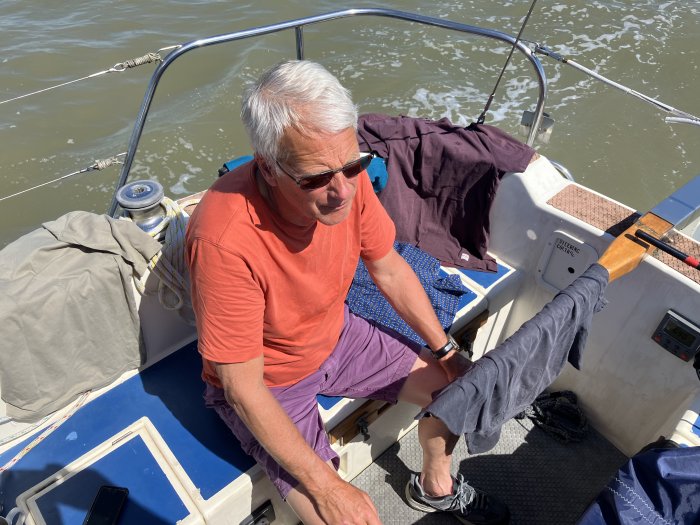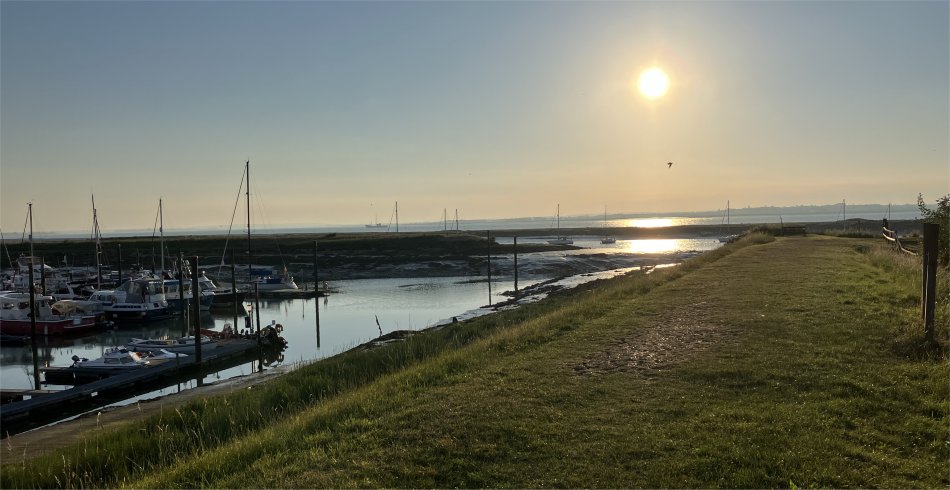 Drying Out his Clothes |
Once we had turned the corner past the Naze at Walton, Rex retrieved a bag he stored his clothes in, which was kept under his bunk. Bilge water under the bunk had managed to penetrate his "waterproof" bag and dampen some of his clothes. In a short while he had all his damp clothes draped over the cockpit, hoping the scorching sun would dry them. The observant reader may have noticed we have experienced constant sunshine whilst being back in the UK. The world really has gone topsy turvy.
He then set about, once again, sponging all the bilge water slopping about under the floors in the front half of the boat. Whilst in Shotley, he had ordered a new water pump to replace the current one that we knew to be leaking. Hopefully, replacing the leaking pump will eliminate the bilge water problem. If is doesn't, we will then know there is at least one leak elsewhere. Meanwhile we soldiered on with the existing water pump switched off as much as possible.
With no wind at all to fill the sails, we motored all the way to Bradwell. As we neared the marina, another yacht squeezed in front of us, and proceeded at 1 knot. This drove Rex hopping map. He really is a boy racer on the quiet; watching him hurtle into locks in Holland is a whole new experience.
We scored 10 out of 10 for entry into our berth, it was flawless. It was a pity that there was no one around to witness it.
Bradwell, or Bradwell-on-Sea as it is also known is a small Essex village on the Dengie peninsula, near where the River Blackwater meets the North Sea. It was a Saxon Shore Fort in Roman times, known as Othona, with 12-foot-thick walls and a moat, but little has survived. The Anglo-Saxons knew the area as Ithancester and it has also been called Bradwell-juxta-Mare and Bradwell-next-the-Sea in its long history.
In 653 AD Saint Cedd was sent by Pope Gregory to found a monastery and bring Christianity to Essex. The building has survived as the old chapel of St Peter-on-the-Wall and it is the oldest church in England. When a new church was built in the centre of Bradwell, the old church building was used as a navigational aid to shipping. By the 17th century, it was being used by a farmer as a barn. However, in 1920 it was restored and reconsecrated although the chancel, apse and tower were long gone. Today St Peter's Chapel remains a place of pilgrimage and is always open.
In the 13th century, Bradwell built a quay and from it, wool was exported. Records from 1478 show a ship called the Christopher carried wool from Bradwell Quay to Calais.
During the Second World War the airfield sited to the north-east of Bradwell Waterside was a front-line station, and named RAF Bradwell Way. Before the war a small grass airfield was sited there for refuelling and re-arming the aircraft used by pilots practising shooting and bombing at the ranges on nearby Dengie Marshes. In 1941 the airfield was enlarged, swallowing up the pre-war grass landing ground, and three concrete runways were laid down. As it was quite near the coast, and many aircraft in distress landed there, it had a Fog Investigation and Dispersion Operation (FIDO) system installed to help pilots find a safe landing in foggy weather. Many night-fighter squadrons were based here, equipped first with the Douglas Havoc, then the de Haviland Mosquito, the ubiquitous multi-role-combat aircraft of its time. The airfield was also used as a jumping-off point for fighters escorting long-distance bombing raids on Germany, and such types as the Spitfire and North American Mustang could be seen. A recent memorial, in the shape of a crashed de Havilland Mosquito, has been placed near to the edge of the airfield to remember all those who lost their lives in defence of Britain in the war whilst based at RAF Bradwell Bay.
In more recent times, Bradwell-on-Sea hit the headlines as the site of Bradwell A Nuclear Power Station. It was closed in 2002 and has since been decommissioned.
This stretch of the coast is one of the only sandy beaches on this part of the coast. The area known as Bradwell cockle spit is popular as a haven with families and dog walkers due to its close proximity to the Saltmarsh Coastal trail, spanning 75 miles of stunning coastline in the Maldon District.
It was early afternoon. We paid the harbour master his dues, and had a lunch at the popup café near the office. It was here where Rex made some new chums. They were with the Essex Police Marine Unit. He interrogated them about the severity of marine related crimes in the area. Apparently the crime rates have reduced, the monetary value of objects being stollen being miniscule. As Rex commented, more damage is created by the forceful breaking into a boat, being a much larger cost to the boat owner than items stollen.
Then we had the inevitable amble around the boatyard and back to the boat. The heat was oppressive. According to one of the instruments on board it registered 35 degrees outside. I opted for a nap followed by a blissful cold shower and head shave.
 Bradwell Power Station on the Horizon |
On our return back to the marina, I paid a trip to the shower block while Rex returned to Duonita. On my return to the boat, I bumped into a Dutch couple who were on a boat moored quite close to us. I exchanged greetings with them, and offered my condolences on the Dutch team's loss against Austria. They laughed, and obviously couldn't care less.
"Where in Holland do you come from?" I asked.
"Hellevoetsluis," was the swift reply.
"Ah, Hellevoetsluis on the Haringvliet, a very pretty town," I replied. They seemed pleased I knew the town, and even more pleased when I told them we had visited the town the previous year.
"We have just spent three weeks in Holland," I informed them. "We originally intended to sail up to the Wadden Zee and Friesland, but the weather was against us. On this trip we got as far north as Dordrecht, but we managed to visit quite a few places we hadn't been to for a long time. Where are you heading to in the UK?" I asked.
"We sailed across to Harwich, then visited Brightlingsea, before we went up the River Orwell to Ipswich. There are some lovely old buildings in the town, but many of the shops are closed down. We have similar closed down town centres in Holland. We hired a car there and visited Colchester and Thetford."
I asked them if they visited Grimes Graves near Thetford. I tried to explain what they are, and why they were there, and when they were created, but the deeper I got into this and the geology of flints, the less and less they understood. Eventually I let it go.
"We are off to Burnham-on-Crouch tomorrow, then back to Tollesbury where the boat is normally moored, then repair the boat."
"Ah, we have heard of Burnham-on-Crouch, but never been there. We like this coastline, there is lots of space and it is quiet. We've visited the south coast before, but it is very busy, loud and expensive down there."
"What are your plans for the rest of this trip?"
"We aim to visit Heybridge Basin, then get down to Chatham to visit the Historic Naval Dockyard."
"One of your countrymen also visited Chatham, Admiral Michiel de Ruyter, if I'm not mistaken," I joked with them.
"Ha ha, yes we know all about those stories," they laughed.
"Then we will sail to Ramsgate, Ostend and back to Hellevoetsluis."
They were a happy, friendly couple, and I wished then a safe journey.
Under a warm, cloudless sky at a very low tide, Rex and I listened to a 1971 Doors Album - L. A. Woman, followed by Rex giving me a potted history of the band.
Perhaps I should start giving him hourly lessons in Dutch.
 Sun Going Down Over Bradwell |
